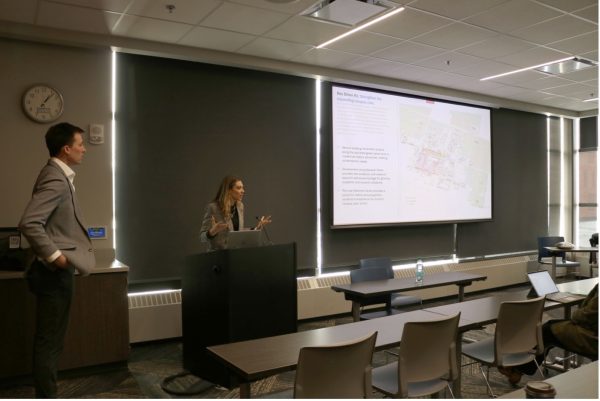SDSU to disaffiliate from Student Federation
April 11, 2016
South Dakota State University student government leaders announced the institution would be disaffiliating from the Student Federation because of a disagreement on the organization’s budget and bylaws on March 31.
The University of South Dakota also announced it would leave the Student Federation.
The Student Federation is an umbrella organization for the six South Dakota Board of Regents institutions. It is a voting body that lobbies on behalf of the voice of the students at each of the universities. Universities include SDSU, USD, Black Hills State University, Northern University, Dakota State University and South Dakota School of Mines & Technology.
With the two institutions choosing to disaffiliate, members of the Student Federation are worried the organization will be dissolved without the two schools’ representation.
The organizations are not technically disaffiliated until each university’s student body government reaches a two-thirds vote to leave the Student Federation. The SDSU Students’ Association will debate and vote on this in its April 11 meeting.
Representatives from SDSU announced they were leaving the Federation because of a “dual-fronted disagreement,” said Matt Dahle, SA vice president and Student Federation representative.
The disagreement focused on how SDSU pays more than other institutions. They believe they aren’t getting the same value out of it as other institutions and because of an ideological disagreement.
But Dahle doesn’t plan to stay out of the Federation for long.
“It doesn’t benefit us in the long run to stay out and have two groups fighting against each other all the time,” he said. “We want to work forward and have a mutually beneficial resolution.”
SDSU paid $1,975 to be represented on the Student Federation this year. This was 34 percent of the budget and represents the number of students attending SDSU compared to the total number of students in the SDBOR system.
Since SDSU has the largest number of students, SDSU paid the most. USD came in second, paying $1,627. The school paying the smallest amount was SDSMT with $465 and 8 percent of representation.
Recommendations, made by Dahle and a committee looking into Student Federation budget changes, were to create a flat rate of $250 to pay for Students for Higher Education Days (SHED), eliminate a budget for travel expenses, establish chair positions from representatives to take the place of an executive board and stipends of the position. This plan would cost $1,500.
A change to the bylaws was also recommended so that representatives of each university were responsible to reflect the wishes of each person’s school.
Every school except for SDSU and USD vetoed these changes.
Olivia Siglin, former legislative director for the Student Federation, said these proposed changes didn’t take into effect the necessity of travel for smaller schools or the worries smaller schools had about the changes.
“I think a lot of them [smaller schools] are open to changes in general and how to make the organization better, but it’s going to make it hard for SDSU or USD to make it better if they aren’t part of those conversations,” Siglin said.
Even though SDSU and USD aren’t seeing the value of being part of Student Federation currently, Siglin said, “they’re getting a lot of benefits that they don’t necessarily see.”
Travel costs were about $1,300 for the schools, not including SDSU, which paid for travel on its own. The other costs of the Student Federation’s budget were for stipends for an executive board, at $3,000, and for SHED, which was $1,480.
Siglin said the main thing SDSU was forgetting was the value they received in this situation during SHED. SDSU and USD brought more students to the event than other schools, which took up more of the SHED budget.
The Student Federation voted to make changes in an effort to compromise with a smaller budget that SDSU and USD supported. This included setting a flat rate of $300 from each university and then adjusting the rest of the budget to pay per student. The responsibilities of the executive board were also consolidated to two positions so $1,000 could be cut from the budget.
This change would have SDSU paying about $1,340 next year, cutting its last payment by more than $600.
“That lowers the financial burden, sure, but it doesn’t fix the ideological issues of it,” Dahle said in regards to the changes.
Dahle still felt that changes in the bylaws should be made to reflect individual institutions instead of saying that representatives had to represent all students of South Dakota.
He also said since SDSU would still be paying more, there should be a change in voting representation since the university also has more students to represent. Giving the university an extra vote could solve this, he said.
To relate to how Student Federation needs to change how it represents each school, Dahle cited a disagreement earlier this year between the Student Federation and USD in regards to a tuition freeze. Although every other school supported the tuition freeze, the USD student body voted for a General Activity Fee increase last year which wouldn’t be accomplished if there were a tuition freeze.
USD representatives didn’t feel comfortable lobbying against the Student Federation’s decision and so did not voice the opinion of the university, Dahle said. This cost USD $750,000.
“We shouldn’t force ourselves to have a consensus if there is no consensus,” Dahle said.
Robert McLean, SA senator and newly elected executive director of Student Federation, said he would not want a university to step back or to silence a university as in the situation with USD.
McLean’s solution for SDSU and USD leaving the Student Federation is to take steps throughout this summer and the next year to fix the situation. McLean plans to start communication between all representatives to find a compromise.
“With this organization, or any organization really, I think it’s key to take steps throughout a period of a year instead of trying to change it all at once at the end of the year,” McLean said. “I don’t think that’s a necessary step to take when you’re considering changing the way an organization works.”
Using conference calls as a medium for communication, McLean thinks this method will allow the organization to work toward a solution faster and not have to catch up the next semester.
McLean said he is in support of a flat rate being implemented for all schools; he still thinks it’s important for SDSU to stay with the Student Federation.
Although Dahle thinks it’s more beneficial for SDSU to be part of the Student Federation, he said SDSU’s “voice doesn’t diminish by not being part of the Student Federation.”
SDSU can still team up with other institutions to lobby for or against certain issues. The university will still have a strong voice, “just in a different form,” he said.
But it doesn’t make sense to Siglin if SDSU and USD aren’t part of the Student Federation. The organization is meant to be the voice of the more than 36,000 students in South Dakota, but both institutions make up more than 60 percent of those students.
“If we are lobbying on behalf of the students of South Dakota, we won’t be able to know what the perspective is of 60 percent of the students are if we don’t have representatives from the big schools,” Siglin said about how the disaffiliation of both schools would hurt the organization’s credibility.
The Student Federation operates as a “unified force,” according to McLean. Without SDSU and USD it wouldn’t be a unified voice of South Dakota, but of four out of the six SDBOR universities.
“Truly, I can see this organization falling apart,” McLean said, “and that would be because of the two institutions leaving.”




















